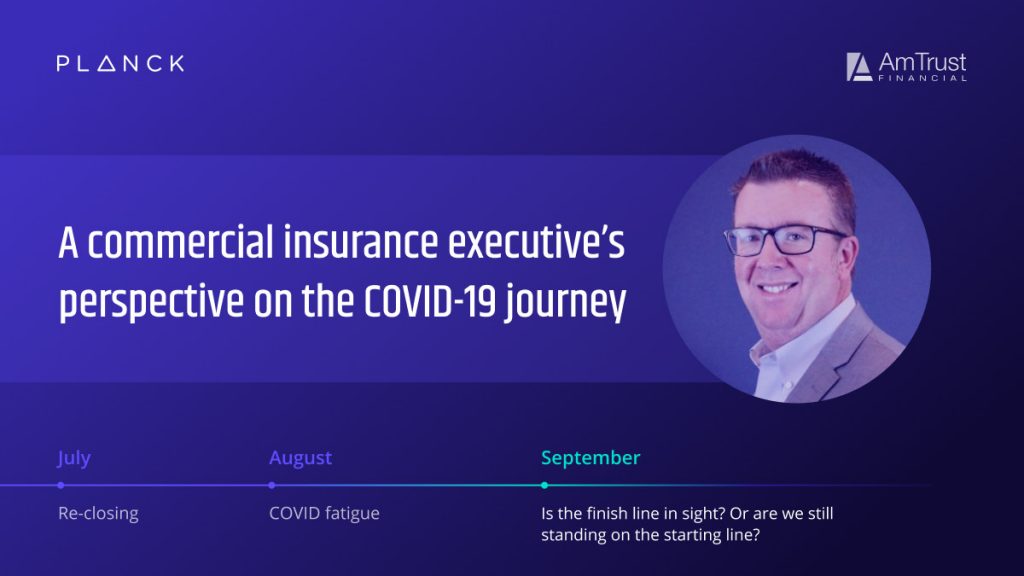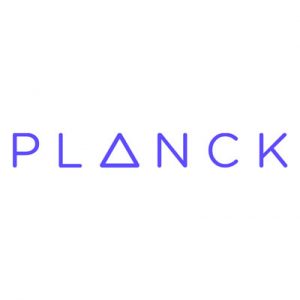A commercial insurance executive’s perspective on the COVID-19 journey
A COVID-19 diary by Matt Zender, SVP Workers’ Comp Strategy, AmTrust
By David Schapiro
Interviewer notes:
I have known about Matt and his work at AmTrust for a long time, but I recently had a chance to speak with him in a COVID-19 roundtable hosted by Planck. Matt has taken the time to document his key thoughts in a monthly manner, providing us with a “commercial insurance executive’s thoughts along the COVID-19 journey.”
It is an exciting stream of consciousness that takes us through the last half year, from when the coronavirus was a faraway thing to when it became a significant part of our lives.
A commercial insurance executive’s perspective on the COVID-19 journey, March–September 2020.

March – Transitioning (seamlessly) to a work from home (WFH) environment
- Addressing the needs of our insureds. Creating resources to address financial concerns such as payment terms, deferral, endorsement of payroll. Leveraging existing resources to build bandwidth and meet demand.
- Working as closely as possible with our agents and helping them transition to a new work dynamic. How do they fight to attain new business in an environment wholly focused elsewhere?
- Tracking state-by-state regulatory changes. Setting up a framework to allow distribution of critical information for insureds to ensure they meet the changing requests and requirements of different states. For example, training staff on the moratoriums that the states have put in place and what that means for us from an operational perspective.
- Stress modeling. Creating a system to enable AmTrust to estimate and track changes in our book (cash, premium, etc.) by state and by industry segment to anticipate impact and proactively address where possible.
April – How will businesses be affected?
- What small businesses will emerge? Who will change operations? Are we comfortable with the exposure impact of either? What industry segments require underwriting changes?
- Impact on revenue of insureds based on required updates for safety. How much will they need to spend to maintain safe work environments from a COVID perspective? Will that cost displace the dollars spent and effort expended to work safely in non-COVID-related manners?
- Shift in mix due to WFH and furloughed employees. States and bureaus have created guidance for employees who are now working from home to (generally) get the clerical rate now. They also created a furloughed employee rate of $0 for employees who are getting paid but not working. How does this mix shift affect us?
- Tools and analytics to support and thrive in this period of disruption. In addition, monitoring third-party applications to stay on the cutting edge of what is available to help both our policyholders and our portfolio.
May – Businesses start to look toward reopening.
- As businesses start to look toward reopening, will they be able to find employees? Will there be resistance from employees who have effectively been given a raise by receiving unemployment and other assistance while staying at home? If new employees are hired, will they have an impact on claim frequency usually seen with new employees?
- Impact of PPP/SBA. How many businesses were planning to close but are remaining open due to grants? Federal grants incentivize businesses to reopen.
- Compensability presumptions. State expansion of historical views toward virus-related claims will have a large impact on profitability. How do we view these orders in states like California, New Jersey, and Kentucky, and how do we reconcile the industry-wide estimates against our book?
- Employers’ liability/Part B. Is exclusive remedy under attack? As businesses look to reopen (or are ordered to remain open) what are the businesses’ exposure to tort action in the event their employees are affected? What is the standard of care? What is the role of the federal and state government in this? How can businesses open safely and make certain that they are not exposing themselves and their employees?
June – Behavioral/Economic impact
- As state-mandated moratoriums on cancellations are lifted, how is the book being affected? How many of our policyholders that had not paid their policy were doing so by design versus doing so because they were intending to close their shop? We are closely monitoring the ratio of cancellations and reinstatement.
- Business reopening part II. As businesses reopen, many have used the time off to contemplate their business model. Have they emerged amorphous and without clear direction, or simply different? As we evaluate those differences, how comfortable are we with the change in their risk exposure
- Behavioral/Economic impact. Consumers are clearly influencing the marketplace, and their level of concern is driving many industries and varying by geography. More affluent neighborhoods and “in-person contact” businesses are both seeing a much more negative impact. This is reflected both in terms of consumer spending and in job displacement. How will this affect business failure?
July – Re-closing
- As states see surges in COVID cases and start to mandate closures, how many businesses can withstand this second wave? How many are negatively influenced by the additional burden placed on them during the first reopening and are using this to shape their opinion on the likelihood of a sustainable position in the future?
- Moratoriums part II. States are lifting the moratorium and easing carriers’ ability to cancel in the event of non-payment. What is the balance between expecting that an insured should pay and being compassionate toward their plight? We are seeing instances where one could argue there’s entitlement or at least an attempt to push the edges of the window on the envelope.
- COVID claims. COVID claims begin to flow in. How are the traditional investigative tools holding up, even in light of a COVID presumption? Is operating within the guidance of the Centers for Disease Control and Prevention enough to deny a claim, or are these a cost of doing workers’ compensation in 2020?
August – COVID fatigue
- As employees, insureds, and agents continue managing the pandemic, how do we keep energy levels up? This is especially challenging given the continuing uncertainty and the inability to answer questions definitively.
- Thought leadership. Especially in light of the uncertainty, relevant thought leadership is as important as it has ever been.
- Drawing from the well. As the pandemic stretches into its fifth month, and there is no immediate end in sight, we tend to narrow our contact list, going back to those with whom we are most familiar. It can be challenging to stretch those contacts, so it is important to utilize resources that are available and to push folks to challenge themselves to avoid repeatedly going to the same well.
September – Is the finish line in sight? Or are we still standing on the starting line?
- Facilitating ease of use through technology. Many of the action items taken will stick. Which of those items can we draw from and enhance, and what opportunities exist? For example, we have been forced to move much of loss control into a virtual world. Will technology allow us to derive what’s helpful from the inspection (identifying opportunities to assist our policyholders) while replacing what’s tedious or dangerous (timely in-person visits)?
- Premium movements. As affected policies start to come up for final payroll audit, inclusive of periods that were influenced by COVID, how can we make the transactions as simple as possible for the insureds? Will that effort result in adverse selection or data manipulation, and how can we control against that?
- Stimulus, what stimulus? As the prospects for government stimulus dwindle, are there businesses that will wilt under the pressure? Will the lack of personal stimulus finally crack the veneer of small businesses? To date, the closure data looks generally promising. Is this based on reality or hope?
Bio – Matt Zender, Senior Vice President, Workers’ Comp Product Manager, AmTrust Financial Services
Matt Zender is Senior Vice President, Workers’ Compensation Strategy at AmTrust Financial Services, Inc., one of the largest writers of workers’ compensation in the United States. He has served in this role since joining AmTrust in August 2013. Prior to AmTrust, he spent 15 years at Sequoia Insurance, most recently as Vice President, Workers’ Compensation and previously as AVP, Claims. Zender began his insurance career at Crawford & Company, where he spent 13 years and worked his way up to Vice President – Regional Manager. He holds a bachelor’s degree from Whittier College in Southern California and various industry designations including AIC, WCP, and the California Self Insurer’s certificate. Zender currently serves as the Chairman of the Board of the California Workers’ Compensation Institute, on the Board of NYCIRB, on the Classification & Rating Committee for WCIRB, and on the UW Committee for NCCI.

